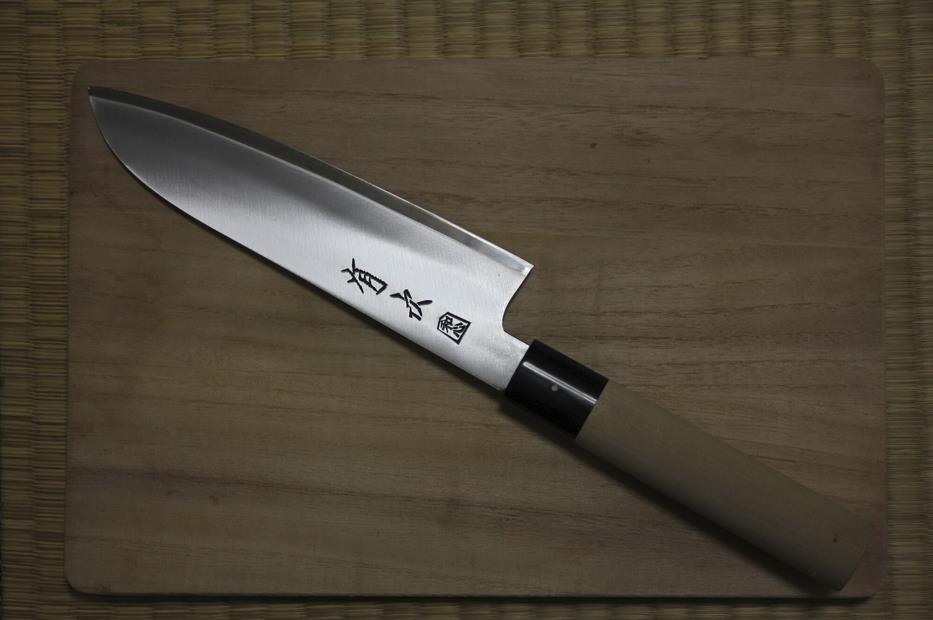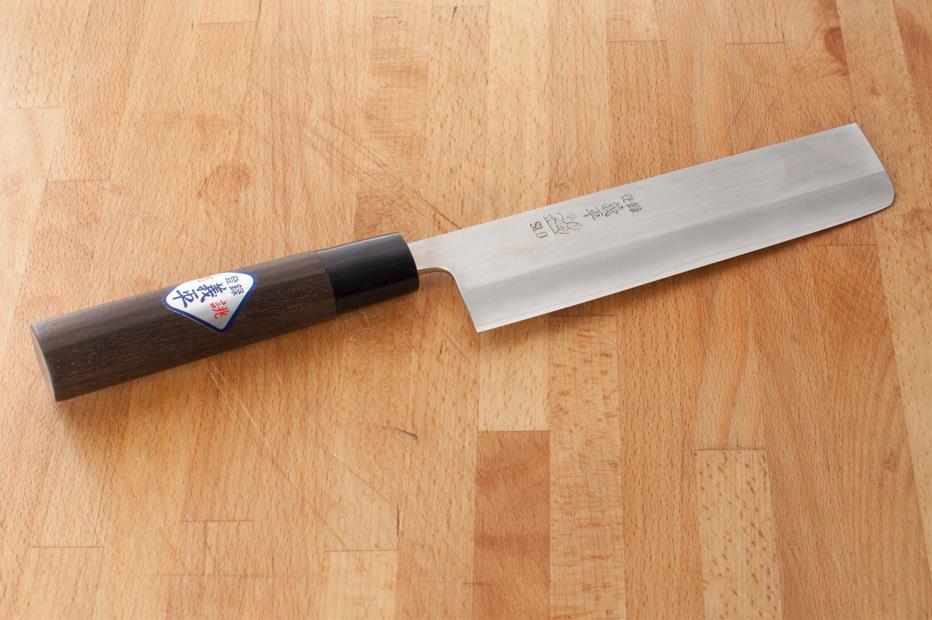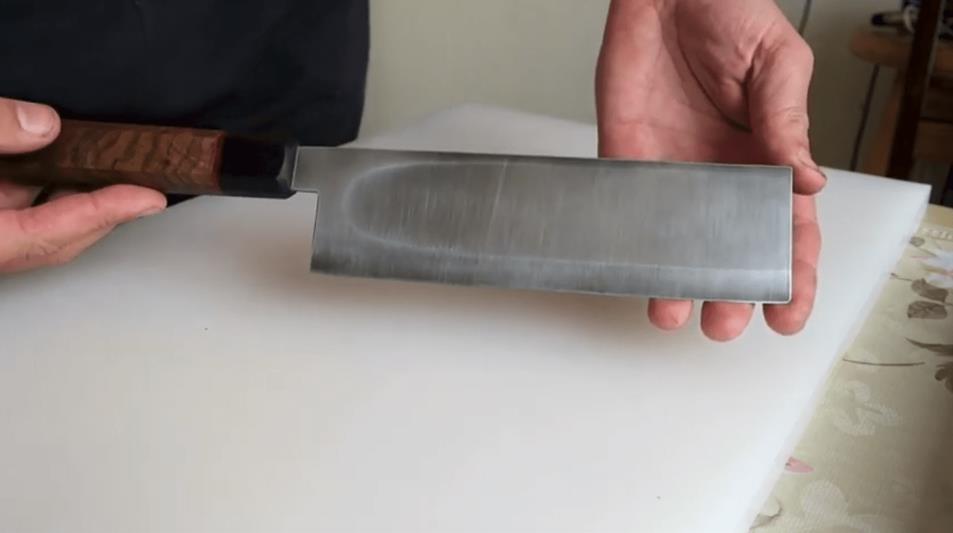The usuba and nakiri Japanese knives are two popular styles that are quite similar. Both feature thin rectangular blades with round handles. Both are very sharp and useful for chopping vegetables. So how can we distinguish between them and which should you consider buying?
Usuba knives have a single bevel edge which means they are sharper, though more difficult to sharpen. Also, left- and right-handed cooks need to have the bevel on opposite sides. The usuba is more of a specialized tool that can perform fantastic, delicate work in the hands of a skilled chef. These knives tend to be heavier and pricier.
The nakiri is a more general vegetable knife since it has a double bevel. As a consequence, it is not as sharp as the usuba, but requires less skill to sharpen and can be used by right- and left-handed users. Due to their lower price and smooth vertical chopping motion, this is a more common choice for amateur or home cooks.
If you are interested in preparing Japanese cuisine or simply wish to own a piece of Japanese craftsmanship for your cooking, a vegetable knife is a great tool to have. Unless you plan to buy both, you need a head-to-head comparison between the two knives to make up your mind. That is where this guide will help you.
Table of contents
An introduction to the Japanese knife style

Japan is one nation that is renowned for its expert craftsmanship of knives and swords. In modern times, it has gained a reputation for producing sharp kitchen knives that are both durable and delicate. So what makes Japanese knives different from other styles?
Traditional Japanese-style knives are made with high-carbon steel which is very hard and keeps its edge for a long time. Conversely, this type of metal can be brittle and prone to corrosion. Today, Japanese knives are manufactured with stainless steel and ceramics too.
Since Japanese knives are often made from high-carbon steel, they can have very slim blades and ultra-sharp edges without losing rigidity. This design lends itself to clinical and precise chopping of meat, fish, and vegetables, though not of bones.
A final distinction between Japanese kitchen knives and other styles is the bevel. While some contemporary Japanese knives feature double bevel edges, the original models always had a single bevel. This type of edge has a narrower angle and is therefore sharper. That said, it does take more skill both to sharpen and use this type of knife because it is harder to achieve the fine angle. Also, your hands must be very steady and precise to use a single bevel knife well.
What is an usuba knife?

The word usuba translates to “thin blade” and its full name is usuba bocho. It is a traditional style of Japanese knife used to cut vegetables.
Design
The Usaba knife has a long, thin, rectangular blade with a flat edge and heavy spine. These almost always have a traditional round/octagonal Japanese handle (known as a wa handle).
The edge of an usuba has a single bevel so that it’s only angled on one side ― the Japanese call this kataba. This means that left-and right-handed cooks need the bevel on opposite sides.
How to use it
The usuba’s greatest strength is cutting vegetables into very thin sheets. This is done with a rotary peeling process called katsuramuki. This involves cutting around the surface of vegetables in one continuous motion and is commonly used for radish in Japanese cuisine.
- To start, you must peel the vegetable. Hold the usuba in your dominant hand with the bevel side facing down (on the vegetable). Your hand should be high up on the handle, while your thumb should be placed near the bottom of the edge. Wrap your other hand around the surface of the vegetable to keep it steady.
- Gradually push the usuba’s edge into the vegetable’s skin. When peeling, you can peel a thicker slice. Work the knife around the circumference of the vegetable by sliding the knife up and down. Apply continuous pressure with the knife while pushing the vegetable in the opposite direction with the other hand.
- Once you have peeled the vegetable, you need to cut it thinly. To achieve this, push your knife into the flesh as before. Use the thumb on your knife hand to control the thickness of the sheet as you slice. The thumb on your other hand should help to rotate the vegetable.
- As before, push from both directions to keep cutting, and continue to slide the usuba back and forth. Take your time when doing this because vegetables can be slippery.
- When you have finished, you should have one long, thin sheet of flesh that is ready for further chopping.
- It takes a lot of practice before you can produce a continuous, wafer-thin sheet. Be sure to check out the video above to see how a professional chef performs katsuramuki.
Pros
- The usuba can be incredibly sharp with a very small blade angle, which makes it perfect for making clean cuts through tougher vegetables.
- The usuba is sturdy and heavy. This means it can cut downwards with considerable effect, without you having to push hard or slide the knife back and forth excessively.
Cons
- Owning an usuba is not for the faint-hearted or beginner chefs. It takes considerable skill both to use the knife and sharpen it. Achieving a consistent and fine angle across the blade is not easy and takes patience and experience with a whetstone. Also, just because the blade is sharp does not mean you will be effective with it. It could take years to become proficient with this knife.
- This knife is not only harder to use and maintain; it is harder to produce ― mainly due to being so thin. As a result, a good-quality usuba will cost more than a nakiri.
- Left- and right-handed users have to use a different usuba with the bevel on opposite sides. Therefore, this tool is not as versatile since it does not necessarily fit everybody.
What is a nakiri knife?

The nakiri’s full name is nakiri bocho which translates as “leaf cut knife” from Japanese. This is a general-purpose knife used in Japanese cuisine to prepare vegetables.
Design
The shape of a nakiri is similar to that of the usuba; it is slim and rectangular, though typically not as long and without such a heavy spine. Nakiri knives are available with traditional Japanese and Western handles.
The edge of a nakiri has a double bevel, which the Japanese call ryoba. The double bevel edge has a symmetrical “V” shape so that right- and left-handed users can use the exact same knife with no problems.
When looking at a nakiri, you may notice that it closely resembles a meat cleaver or Chinese caidao knife. However, those knives are meant to cut meat, so have thicker blades.
How to use it
- The flat cutting edge with a symmetrical bevel is ideal for slicing dense vegetables vertically, for example, onions or cucumbers. A nakiri is often heavier towards the tip, so for optimal balance, you should grip the bottom of the blade with your thumb and index finger. Your three other fingers should wrap around the handle.
- Press down on the vegetable with your non-dominant hand to secure it to the cutting board. In the case of onions or cabbage, it is sensible to cut them in half first and rest them on the flat side so they don’t roll.
- Hold the nakiri horizontally above the vegetable and slide it downwards and forward to make a cut. Then, pull the knife backward (along the cutting board) to complete the slice. You can rest the nakiri’s flat face against the fingers of your non-dominant hand to control the thickness of the slices.
- An alternative technique is to cut into vegetables in one clean motion by holding the nakiri at a 45° angle and then repeating for the entire length. For more information on using this knife, see the above video.
Pros
- A nakiri is generally a very affordable knife. Even high-quality models are mostly in the $100-200 price range.
- The double bevel edge of the nakiri is easier to sharpen and accessible to both left- and right-handed cooks.
- The nakiri is versatile because you can cut many ingredients with different techniques. It is a very accessible knife, so beginners can successfully use it without special training.
Cons
- A double bevel edge will always have a larger angle than a single bevel. Therefore, a nakiri will never be the sharpest knife.
- It is possible to recreate many of the nakiri’s cuts with a well-designed chef knife, so it may be unnecessary for some cooks.
How are the usuba and nakiri similar?

Both are Japanese vegetable knives with thin, rectangular blades and straight edges. Both are often made from high-quality carbon steel that does not blunt very easily.
Another similarity is the handle; a lot of usuba and nakiri knives have traditional Japanese wa handles. Unlike Western types, these have no ergonomic grooves but a round or octagonal profile instead.
Usuba vs nakiri: comparison table
| Usuba | Nakiri | |
| Application | A specialized knife that produces extra thin slices of vegetables. This is appropriate for professionals and knife enthusiasts. | A general-purpose knife for chopping vegetables. This is suitable for all skill levels. |
| Blade shape | Long, thin, and rectangular. | Long, thin, and rectangular. |
| Edge type | Single bevel | Double bevel |
| Price | Expensive. Some of the better models cost well over $200. | Affordable. You can find a very decent quality nakiri for under $100. |
| Maintenance | Difficult. It takes a lot of practice to sharpen a single bevel knife properly. As a beginner, your best option may be to take your usuba to a workshop. | It is not much harder to sharpen or hone a nakiri than a standard chef knife. |
Which one should you buy?
For most people, the answer is very straightforward: a nakiri. This knife will satisfy most of your needs when it comes to chopping vegetables. An usuba is pricey and does not give you much additional functionality. Also, it is tricky to maintain, so this is only a sensible purchase for experienced chefs or knife enthusiasts.
A nakiri is easy for beginners to use and often reasonably priced. With that said, if your budget is not very big, you can save money by choosing a solid chef knife instead. A chef knife can replace the nakiri since it can perform most of its jobs. It can also prepare other ingredients like meat and fish too.









